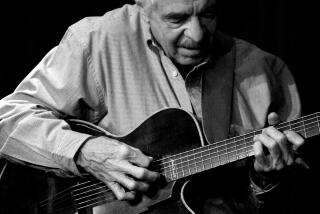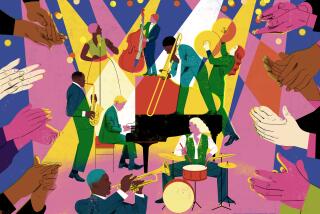POP BEAT : VAN EPS IS MUSICIANS’ MUSICIAN
- Share via
For the past two years, George Van Eps, who is regarded as one of the pioneers of jazz guitar, has performed regularly with another local guitarist, Tony Rizzi, at the Sunset Pub in Sunset Beach. Tonight, the Rizzi-Van Eps quartet opens a two-night stand at McCormick’s Landing.
By example, not braggadocio, the 71-year-old Huntington Beach resident is quietly doing his part to steer young guitarists onto the right musical track. “Wherever we go, most of the audience consists of guitar players, and the nice thing that’s happening is 50% of the audience is young kids,” said Van Eps, who plays an unusual seven-string guitar that he developed in 1937. “The ‘rockers’ are showing an interest. Tony and I don’t look down our noses at them. We’re delighted they’re finding out there’s more to music than four chords.
“They’ll say, ‘There’s something else going on there. What do you call that?’ And I’ll say, ‘Well, that’s counterpoint.’ I get mail with questions like that from kids all over the place.”
In Van Eps, these aspiring guitarists have a top-notch role model. His four-page resume cites professional associations with Frank Sinatra, Ray Noble, Jo Stafford, Nelson Riddle and Peggy Lee among dozens of other big names.
Van Eps, who grew up in New Jersey, worked for many years in New York. He moved to the West Coast about 40 years ago. He put out his first instruction book in 1938. And in 1982, he published “Harmonic Mechanisms for Guitar,” a 1,000-page three-volume textbook distilled from more than 16,000 pages of manuscripts, notes and musical ideas assembled over four decades.
Although he no longer has the time or inclination to give private lessons, he has had some fairly prominent pupils. “Benny Goodman was a student of mine--not formally--but he used to come to the apartment on 55th Street in New York, where we’d hole up in a bedroom,” said Van Eps, whose voice recalls Jimmy Stewart’s in its warm, avuncular demeanor.
“Benny liked to practice my guitar material because, he said, ‘it’s not clarinet-istic--it’s hard as hell to do.’ And after a few months of that, he told me one day, ‘My technique has improved 10%.’ ”
Van Eps doesn’t tell such stories to be boastful. In fact, when discussing his career, his manner is wry and self-effacing, and he’s prone to such modest comments as, “Gee, that was a long-winded answer, wasn’t it?” and “There’s nothing wrong with my memory--it’s just too short to be of any use.”
His memory was not too short, however, to remember being bit by the music bug as a young boy whose parents and three older brothers were professional musicians. “I was absorbed by music right from the cradle,” he said. “I started playing banjo when I was about 9 and joined the union when I was 11; they had to make a special concession because the minimum age was 16. I was working with grown-ups who were all union, so they couldn’t have a little 11-year-old scab in there.”
Van Eps switched from banjo to guitar when he was 13. Curiously, though, the instrument that has most interested--and influenced--him is piano. “From the earliest days,” Van Eps said, “I tried to play piano on the guitar. I wanted to copy that sound.” He said the reason he didn’t simply switch to piano was that his mother and brother, Robert, were both accomplished pianists and he “wasn’t going to compete with them.”
Instead, Van Eps opted for a rather inventive alternative: a seven-string guitar that he created nearly 50 years ago to enable him to explore the range of harmonies otherwise limited to piano. With a few refinements, the seven-string guitar, or “lap piano,” has been his primary instrument ever since; it’s the one he used for most of his jobs with radio and television orchestras and in his contributions to film sound tracks and recording sessions.
Asked to select the artists with whom he most enjoyed playing over the years, Van Eps rattles off such names as Mel Torme, Jo Stafford, Joe Williams, Jack Webb (for the “Pete Kelly’s Blues” radio, TV and film projects), Ella Fitzgerald and Frank Sinatra. “I always enjoyed the Sinatra dates,” he said, “because Frank is an excellent musician whose suggestions are always good.”
However, he was quick to point out that to pay the rent, he often took work that wasn’t nearly as artistically gratifying. “I worked with Liberace in the studio for four years,” Van Eps said sheepishly, “and then I went home every night and washed out my ears.”
LIVE ACTION: Tickets are on sale for the Reggae Sunsplash USA show featuring Third World, Dennis Brown, Gregory Isaacs, Lloyd Parkes, and We The People at the Pacific Amphitheatre May 12 . . . Dave Mason will play the Golden Bear in Huntington Beach May 4 . . . The Living Daylights will play the Pub at Cal State Fullerton May 2 . . . The Vandals return to Spatz in Huntington Harbour May 10. . . . Johnny Lee will play the Crazy Horse Steak House in Santa Ana May 13.
More to Read
The biggest entertainment stories
Get our big stories about Hollywood, film, television, music, arts, culture and more right in your inbox as soon as they publish.
You may occasionally receive promotional content from the Los Angeles Times.










